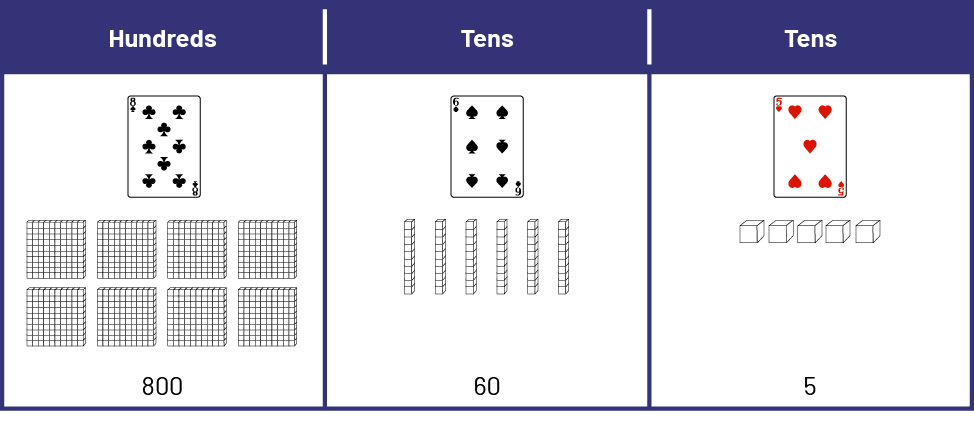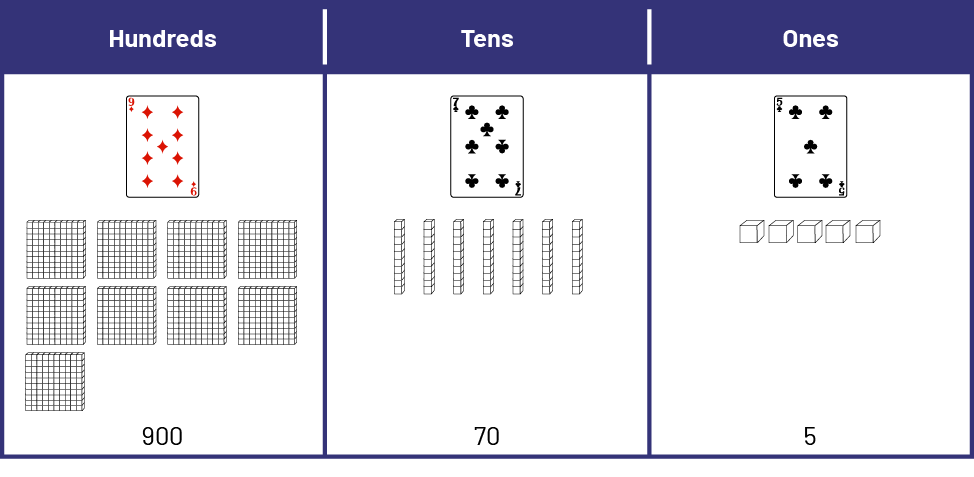B1.5 Use place value when describing and representing multi-digit numbers in a variety of ways, including with base ten materials.
Activity 1: What Is My Value?
Directions
Write a number on the board and read it with the students (for example, 46). Ask them to tell you how many ones and tens there are in that number.
Ask students to represent this number with objects.
Point to the 6 in 46 and ask them to show you what the number 6 represents with the objects in front of them. Do the same with the number 4 in the tens position.
Observe which students show you only the number of tens and which students show you the quantity of the value of that number. For example, in the case of the number 4 in 46, there are students who will show 4 objects for the number 4 and others who will show 40 objects.
Ask the following question to students who have shown only 4 objects.
- You have 46 objects in front of you. You say that the number 6 represents 6 objects and that the number 4 represents 4 objects. What do the rest of your objects (36) represent?
Point out the different answers and ask students to think about them and discuss them with their neighbour.
Facilitate a small discussion to bring out what they have been discussing.
Combine the objects into groups of 10 to point out that there are 4 groups of 10 and that these 40 objects are represented by the number 4 in the number 46. Lead a discussion to point out that the 4 in 46 does not represent 4 objects, but 40 objects or 4 tens (4 groups of 10 objects).
Repeat with another number.
Start again using coins.
Note: It is important to choose a number that has a larger digit in the ones place.
Example
Present the following situation to the students.
Zoe won a contest and is given a choice of prizes. She must choose whether she wants the value of the number 9 or the value of the number 6 in 69 cents. She wants to choose the number that represents the greater value. Which choice should she make?
Questioning
- Which choice should she make to get the most money? Explain your thinking.
- What does the number 9 in 69 represent? Represent it with ten frames.
- What does the number 6 in 69 represent? Represent it with ten frames.
- What do you notice?
Note: When you ask students to show you with objects what a number represents in the tens position (for example, the 5 in 58), don't be surprised if several students show you 5 objects. It's important to build a solid understanding of place value in the primary grades. To do this, students need a wide variety of concrete tasks. Later, these concepts will be fundamental to 2- and 3-digit addition and subtraction.
Source: translated from L'@telier - Ressources pédagogiques en ligne (atelier.on.ca).
Activity 2: I Am the Strongest
Introduce the card game "I Am the Strongest".
To play this game:
- students will play in pairs;
- each pair will use the cards from 1 (ace) to 9;
- each student draws four cards and makes the greatest number possible using three of them;
- the student who makes the greatest number gets one point.
Strategy
Compose and compare numbers using place value and base ten material
Below are the cards of two players.

In order to form the greatest number, Peter chooses to use the place value mat. While analyzing his cards, he decides to discard the 3 card. With the remaining three cards, he makes the number 865. Jamila decides to discard the 4 card. With the remaining three cards, she makes up the number 975. To compare their numbers, students use base ten blocks laid out on a place value mat as shown below.
Peter: 865

Jamila: 975

Peter and Jamila compare their numbers:
Peter has (800 + 60 + 5 = 865).
Jamila has (900 + 70 + 5 = 975).
Students first count the number of flats used in the hundreds column. Peter has 8 hundreds and Jamila has 9. Therefore, Jamila's number is higher because she has one more hundred. Jamila gets one point.
Source: translated from En avant les maths! 3e, CM, Nombres, p. 5-6.
